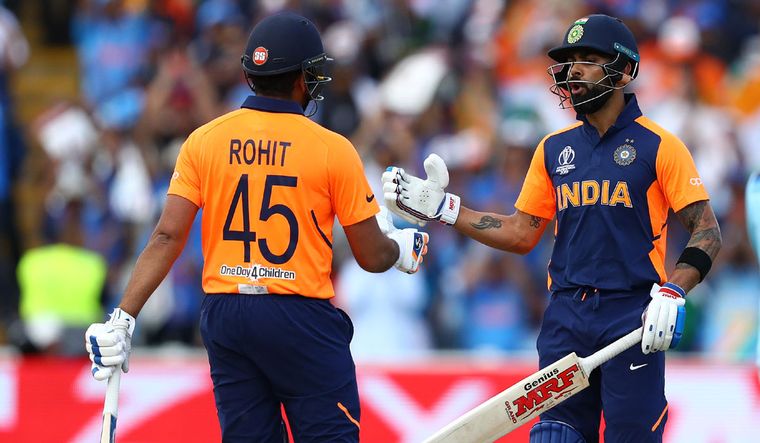THE WAY that Rohit Sharma and Virat Kohli played was mystifying. I know that we bowled brilliantly well during this period, but the way they went about their batting just seemed bizarre. They allowed their team to get so far behind the game. They showed no desire to put any pressure back onto our team, content instead to just drift along, a tactic that was clearly playing into our hands.
In normal circumstances, when as a batting side you are chasing a big score like that, the opening 10 overs is where you really try to get on top of things, to cash in on the fact there are only two fielders allowed outside of the circle.
The intention should be to exploit these gaps, to get ahead of the game, do the work early and not force yourself to be burdened throughout the middle overs when run rates tend to drop. Particularly given their quality, I felt the Indian top order should have tried to be more proactive. Instead they just left the rest of the team with too much to do.
Compared to other leading nations, India were still using quite an outdated method of playing to build their totals, keeping wickets in hand in a bid to cash in at the back end of the innings. Yet that can be a dangerous game because the bigger the score, the less margin there is for any error, and the quicker the required run rate climbs once you hit the second half of an innings.
India needed nine an over when Liam Plunkett continued his running theme of the tournament in the 29th over, adding Kohli to his illustrious list of victims. He not only has a habit of picking up wickets but regularly pouches the big ones. He doesn’t typically knock them over, rather wearing them down instead, but always seemed to be the one getting the crucial breakthroughs. Pudsey became our World Cup partnership breaker, with his wickets coming after the highest average stand of 63. So it was no longer a shock when he got out the vital players.
On this occasion, when Virat was dismissed, from a miscued drive to point, there were a few shrugs of the shoulders and players muttering with smiles on faces: ‘Of course he’s got Virat. It’s Pudsey.’
Arguably, the way that M.S. Dhoni played when he came in with 112 runs needed from 11 overs was even stranger. He appeared more intent on singles than sixes. Even with a dozen balls remaining, India could still have won. Yes, it was a daunting task but it was still possible. Yet there was little or no intent from him or his partner Kedar Jadhav. To me, while victory is still possible you always go for broke.
There is a theory in our camp that Dhoni’s way of playing has always been the same. Even if India can’t win the game, he takes it right to the end to try to make sure that India’s run rate stays relatively healthy. His big thing has always been to give himself a chance of winning by being at the crease for the final over, but he generally likes to stick around to get as close to a target as possible even in a losing cause.
I have witnessed at first hand how successful his tactics can be. During my first season at the Indian Premier League in 2017, I was batting with Dhoni in a match against Sunrisers Hyderabad that was running away from Pune, the team we were representing. When I was dismissed, the equation stood at 56 runs required for victory from 23 deliveries. We won from the last ball of the match; Dhoni was particularly savage on Bhuvneshwar Kumar.
On this occasion it wasn’t until the last over that India, through Dhoni, finally cleared the ropes. In the modern game, when one team has struck 13 sixes in their batting effort, that’s just odd. Not that we were overly bothered because all we cared about was getting the result.
Yet it was weird to hear India captain Kohli whingeing about the size of the boundaries at the post-match presentation ceremony. He said the toss was vital, adding ‘especially looking at the boundary that was quite short. It was 59 metres, which coincidentally is the minimum amount required in an inter-national match. Quite bizarre on a flat pitch. If batsmen are able to reverse sweep you for six on a 59-metre boundary there is not much you can do. And one side was 82 metres.’
I have never heard such a bizarre complaint after a match. It’s actually the worst complaint you could ever make. Both teams have to bat out there, and get the same number of balls, so how can the playing area’s dimensions be an advantage to one team or the other?
—Excerpted with permission from On Fire by Ben Stokes, published by Headline Books and distributed in the Indian subcontinent by Hachette India.

